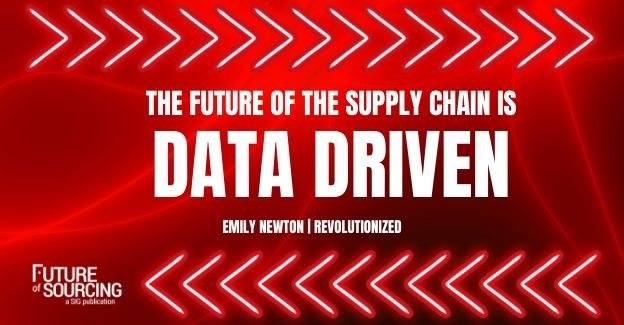Today’s global supply chain is faced with unprecedented challenges and data-driven innovation may be the only way forward, says Emily Newton, Editor-in-Chief of Revolutionized. She shares how big data and analytics can help organizations at every level of the supply chain to increase efficiency, productivity, resource management and spending.
What Does a Data Driven Supply Chain Look Like?
The key to improving any system is information. A data-driven supply chain is built around this concept, leveraging big data and analytics to improve processes at every level of the supply chain. A wide range of technologies contribute to this, from interconnected IoT sensors to warehouse robots and everything in between.
A data-driven warehouse, for example, uses real performance data to identify exactly where and how to integrate a robot into its operations. Similarly, a data-driven trucking company uses real-world traffic, weather, and road data to optimize routes and maximize fuel and time efficiency. Data-driven solutions like these are exactly what today’s supply chain needs.
Solving Today’s Supply Chain Issues With Tech
The supply chain crisis has made it clear that the supply chain needs to evolve to meet today’s challenges. Technology is the only way of accomplishing that. At the heart of the supply chain’s technological transformation is data. Only through big data and analytics can we pinpoint the roots of the supply chain’s issues and resolve them.
For example, one of the initial driving factors behind the supply chain crisis was skewed supply and demand predictions from manufacturers and retailers. Demand for many products was underestimated, causing supply to be insufficient. Data-driven demand forecasting could help prevent this situation from occurring again. The same technology could be applied throughout the supply chain, from shipping to last-mile traffic.
Data has also become critical in the warehousing industry. In the midst of a severe shortage in warehouse real estate, warehouse owners and managers need to leverage data to maximize the value of the space they do have. Data-driven warehouses can operate more efficiently, maximize the usage of every square foot and optimize inventory management.
Arguably the most challenging issue in the supply chain today is congestion at international ports. Data-driven ports could work with shipping companies to manage traffic and minimize waiting times. On the domestic end of things, trucking companies could use data to maximize the efficiency of their operations, which would help reduce ports’ container traffic.
Innovating the Data Driven Supply Chain
Data will completely change the way organizations throughout the supply chain operate. Collecting and analyzing data to find solutions is only the first step, though. Data will continue to drive innovation in the next-generation supply chain, building resilience and improving sustainability at every level.
For example, with extensive data, manufacturers can reduce waste through improved forecasting and optimized, automated production. AI and robotics will improve the quality control process, which will help collect even more data for manufacturers to use for further improvements. Similarly, warehouses and shipping companies can reduce waste by automating the picking and packing process, which will also boost efficiency.
Collaboration and transparency will be critical to improving the state of the supply chain in the years ahead. Manufacturers, retailers, and shipping companies need to be able to coordinate effectively and in real-time, with cutting edge logistics. This is already leading many organizations to work with 3PL logistics providers. Logistics specialists will be critical to the future of the data-driven supply chain, asset-based and non-asset-based alike.
Coordination in logistics ensures that the various links of the supply chain are operating together as effectively as possible, with all of the data available. Logistics is especially important in warehousing. With so many individual objects to manage, it is easy for warehouses to operate inefficiently without the problem becoming noticeable. Experts have pointed out that data-driven logistics would drastically increase visibility within warehouses. This opens the door to optimization for inventory organization, employee management and automated warehousing.
The Role of IoT, AI and Robotics
Robotics, artificial intelligence (AI) and the Internet of Things (IoT) are transforming virtually every industry already. These technologies will be a critical part of the data-driven supply chain, helping to both collect and apply big data.
Robots
Robotics have been on the rise in the supply chain for years. Experts have long been in agreement that robots will become a natural part of the supply chain’s workforce in the years ahead. From robotic arms to roving courier robots, these machines are filling the gaps in the supply chain’s labor shortage. They are giving warehouses an edge over competitors through next-gen efficiency and productivity, and they are helping employees work safer and smarter.
Artificial Intelligence
Physical robots are backed by software and data that is no less important, though. Artificial intelligence is the key to moving robots beyond simple machines. It is also crucial to creating fully automated warehouses and manufacturing facilities, which will help reduce delays in the supply chain.
Artificial intelligence can help sort and analyze large quantities of data, faster and with more accuracy than people often can. This allows for detailed, realistic logistics simulations and forecasting as well as maximum optimization in operations. In fact, AI can even be used to automate customer service, which will help retailers and shipping companies stay on top of things during high-traffic times.
Internet of Things
If robotics is the hands of an automated supply chain and AI is the brain, IoT is the senses. IoT devices form a vast interconnected web of real-time data collection tools. A few IoT sensors around a manufacturing facility can spark numerous invaluable benefits, such as cost reduction and greater efficiency. With the extensive data collected by IoT devices, the supply chain can be continuously fine-tuned.
What differentiates IoT sensors and devices from non-IoT connected devices is communication. Not only do these devices collect accurate data, they can communicate that information in real-time, relaying it to other devices. This gives supply chain organizations a live overview of exactly how their facility or asset is performing, from trucks to assembly lines and everything in between. A great example of IoT in action is RFID tracking for robots and inventory around warehouses, which has become popular over the past couple of years.
Advancing the Supply Chain Today
The global supply chain is in the midst of unprecedented challenges. The situation will take time to repair and improve, but technology can help. The supply chain is already in the process of evolving and adapting, becoming data-driven in order to survive and thrive. Data will enable recovery and long-term growth at every level of the supply chain. This widespread digital transformation will create benefits for manufacturers, retailers, suppliers, shipping companies, employees and customers alike.









